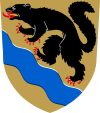Nokia, Finland
| Nokia | ||
|---|---|---|
| Town | ||
| Nokian kaupunki | ||

Nokia church (designed by C. L. Engel) in December 2005
|
||
|
||
 Location of Nokia in Finland |
||
| Coordinates: 61°29′N 023°31′E / 61.483°N 23.517°ECoordinates: 61°29′N 023°31′E / 61.483°N 23.517°E | ||
| Country | Finland | |
| Region | Pirkanmaa | |
| Sub-region | Tampere sub-region | |
| Charter | 1922 | |
| Market town | 1937 | |
| City rights | 1977 | |
| Government | ||
| • Town manager | Markku Rahikkala | |
| Area (2011-01-01) | ||
| • Total | 347.76 km2 (134.27 sq mi) | |
| • Land | 288.18 km2 (111.27 sq mi) | |
| • Water | 59.58 km2 (23.00 sq mi) | |
| Area rank | 265th largest in Finland | |
| Population (2016-03-31) | ||
| • Total | 33,118 | |
| • Rank | 32nd largest in Finland | |
| • Density | 114.92/km2 (297.6/sq mi) | |
| • Demonym | Nokialainen (Finnish) | |
| Population by native language | ||
| • Finnish | 98% (official) | |
| • Swedish | 0.3% | |
| • Others | 1.6% | |
| Population by age | ||
| • 0 to 14 | 19.6% | |
| • 15 to 64 | 65.9% | |
| • 65 or older | 14.5% | |
| Time zone | EET (UTC+2) | |
| • Summer (DST) | EEST (UTC+3) | |
| Municipal tax rate | 19.75% | |
| Website | www.nokiankaupunki.fi | |
Nokia (Finnish pronunciation: [ˈnokiɑ]) is a town and a municipality on the banks of the Nokianvirta River (Kokemäenjoki) in the region of Pirkanmaa, some 15 kilometres (9 mi) west of Tampere. As of 31 March 2016 it has a population of 33,118.
The origin of the name "Nokia" is obscure. In modern Finnish, noki means soot and nokia is its inflected plural, although this form of the word is rarely if ever used. The most common theory claims the name actually originates from the archaic Finnish word nois (pl. nokia) or nokinäätä ("soot marten"), meaning sable. After sable was hunted to extinction in Finland, the word was applied to any dark-coated fur animal, such as the marten, which are found in the area to this day. The sable is enshrined on the Nokia coat of arms. However, later research has appeared to indicate that sables never inhabited Finland in the first place, and the name nois may actually refer to the beaver.
The first literary reference to Nokia is in a 1505 document in connection with the Nokia Manor.
Nokia was the setting of one of the largest battles in the Club War, a 1596 peasant uprising against feudal lords. The peasants, armed with clubs, took up residence in Nokia Manor and won several skirmishes against the feudal cavalry, but were decisively defeated by Klaus Fleming on January 1–2, 1597. Thousands of clubmen were slain and their leader Jaakko Ilkka, who had fled, was captured a few weeks later and executed. The Club War was the last major peasant revolt in Finland, and it permanently consolidated the hold of the nation state. Much later, in the Finnish Civil War (1918), Nokia (along with neighboring Tampere) was a Socialist stronghold and saw some combat.
...
Wikipedia

